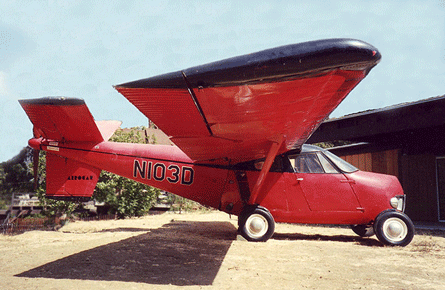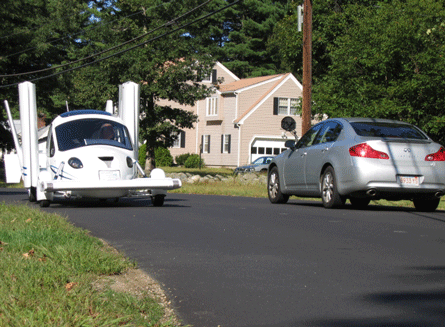Ever since the early 20th century humans have dreamt of flying their automobiles. Now, it seems, they may shortly be able to do so
On eBay there is a Christmas gift sure to garner everlasting gratitude from your favourite aviation buff. All you have to do is buy it.
At $3.5 million, the Taylor AeroCar is a bit pricey, but N103D, one of only a handful of the remaining modular flying cars that gained popularity in the late 1950s, is in a unique position to satisfy your loved one's enduring fantasy for a true curb-to-curb personal transport. The two-seater was designed to loft the lucky driver over the inevitable traffic snarls or allow the pilot and one passenger to get to their destination via roads when thunderstorms and low ceilings make visual flying untenable. They simply remove and fold up the wings and empennage and tow them with the car.
 |
|---|
© Carl FellingThe modular Taylor AeroCar |
Dream on, right? Maybe not.
New breeds of affordable "roadable" aircraft are now being investigated by high-profile entrepreneurs and some are enticingly close to hitting the showrooms at prices a mere mortal can afford. Enabling the potential road revolution in part is the US Federal Aviation Administration's new light sport aircraft category, which lets makers of one- or two-seat aircraft weighing less than 599kg (1,320lb) and following a host of other safety restrictions to be built and sold using ASTM consensus standards rather than costly FAA certification rules.
First on the yuletide list could be the Terrafugia Transition. Woburn, Massachusetts-based Terrafugia, a company started in 2006 by aerospace and business school graduates of the Massachusetts Institute of Technology, says its $194,000 Transition could be ready for customer deliveries by mid-2010. "We're getting very close to deploying for first high-speed taxi tests or flight," says Carl Dietrich, PhD and chief executive of Terrafugia. The company's name is derived from the Latin for "escape from the Earth".
 |
|---|
© TerrafugiaThe Terrafugia Transition is "roadable" when the wings fold against the body, accordion style |
Dietrich says he has firm orders for 60 of the integrated roadable aircraft so far, orders backed up with as much as $10,000 in fully refundable deposits. He is primarily marketing the two-seater to the 600,000 or so general aviation pilots in the USA, focusing on "distinct" advantages of a roadable aircraft. Chief among the benefits are the capability for a visual flight rules pilot to be able to dependably get to a destination by landing and driving if marginal weather interrupts a trip, the cost savings of parking the aircraft in the garage and the ability to use auto gas in the side-by-side seat, four-stroke, 100hp (75kW) Rotax 912S-powered vehicle. Terrafugia says the Transition will have a range of 740km (400nm), a cruise speed of 100kt (185km/h) and will be "capable of highway speeds on the road".
The 1956 AeroCar was not quite the performer, having a range of 480km at 90kt airspeed. Maximum road range for the high-wing pusher-prop vehicle was roughly the same as the air range, with a top road speed of almost 110km/h (67mph). A rare bird indeed, N103D once survived an emergency landing with current Cuban president Raul Castro on board and was later used as a traffic watch aircraft in Portland, Oregon. Although it last flew in 1977, the current owners, who have to sell N103D as part of a divorce settlement, say the aircraft could be returned to service. Interested buyers include "a guy that owns casinos in Las Vegas", a famous NASCAR driver and a person who wanted to trade a gold mine claim, says Carl Felling, one of the owners.
For the Transition, low-speed taxi and driving tests took place in the local Boston area. High-speed taxi tests and possibly its first flight are scheduled to take place this month at a "former B-52 bomber base" in upper New York state, says Dietrich. "It's as close to a dry lakebed as we can get." Closest to Boston is the former Plattsburgh AFB, closed in 1995 as part of the military base realignment plan.
Terrafugia has one proof-of-concept vehicle. Built primarily of carbonfibre pre-preg composite materials with structurally bonded aluminium hard points for the wing hinges and suspension, the twin V-tailed four-bladed canard pusher will transition from aircraft to car by folding the wings accordion style. Dietrich plans to certificate the aircraft to FAA light sport standards and to satisfy the US Department of Transportation road vehicle rules by designing to Insurance Institute for Highway Safety 45mph (72km/h) crash standards.
MOTORBIKE STUDIES
Meanwhile, Nevada City, California-based Samson Motorworks is performing trade studies of side-by-side versus tandem-seated versions of its two-seat integrated SkyBike, a composite body three-wheeled motorcycle with shrouded pusher propeller, nested telescoping wings, stowable twin tail and a canard stabiliser.
 |
|---|
© Samson MotorworksThe SkyBike will transition from three-wheeled motorcycle to aircraft when telescoping wings extend from the body and twin-tails sprout from the rear |
Samson's coupe de grace is that it has teamed with Swift Engineering to build prototypes of the design conceived and patented by Samson president Sam Bousfield. "Swift was interested the first moment they saw it," says Bousfield. "They had been doodling with the idea for years. When they saw what I had done, they were excited." Swift, which has built more than 500 racing cars that have won more than 40 national and international racing championships, also builds the Killer Bee unmanned aircraft for the US military and, most recently, the Eclipse 400 personal jet prototype for the now-bankrupt Eclipse Aviation. Bousfield, whose previous company, Renaissance Research, sought to build a lower-cost, faster and more robust unlimited category racing aircraft called the Dart, says Swift is not an equity partner, although "they're putting their name on the line".
Performance targets for the SkyBike, which will first be built as a $50,000 experimental kit aircraft (not including engine and avionics), are 155km/h on wheels, 122kt in the air, 800km (500 miles) ground range, 350km air range, which amounts to 23.4km/litre (55 miles/USgal) on the ground and 10.7km/litre in the air using an unleaded gasoline-burning motorcycle engine of between 120-180hp. Current plans are to construct the SkyBike with stamped self-reinforcing polypropylene panels (bullet-proofing materials) fastened to a thin-wall steel tube frame, although the frame could migrate to aluminium and the skin to carbonfibre composite.
Bousfield says many potential customers are asking for positions, but the company is not yet ready to accept deposits as key engineering work in unfinished. Swift will next build a one-half scale radio control model of the SkyBike to investigate and verify controls and basic flight characteristics, says Bousfield. The company plans to have a prototype model at the Experimental Aircraft Association's 2009 convention in Oshkosh, Wisconsin in August, although it is probably optimistic to assume it will be flyable.
Other roadable aircraft to watch out for at Oshkosh include Texas-based LaBiche Aerospace's FSC-1, a $175,000 Chevrolet Corvette-powered sports car and aircraft the company is building first as a kitplane. The first prototype is under construction. There is also the $450,000 Milner AirCar, a Honda Civic-sized four-door integrated roadable aircraft the Washington-based company hopes to build as an experimental aircraft, and the Caravella CaraVellair, a single-seat flying motorcycle. Terrafugia and Samson also displayed their aircraft at the 2008 Oshkosh show.
While N103D may very well be best suited for a museum given its age, there appears to be no shortage of willing participants ready to hop into the driver seats of its descendants. "There's an incredible amount of interest," says Terrafugia's Dietrich. "The human race has been dreaming about these vehicles since the early 20th century."
Source: Flight International
















